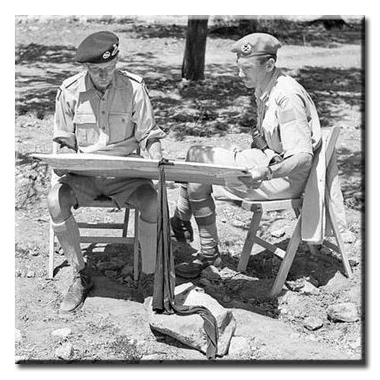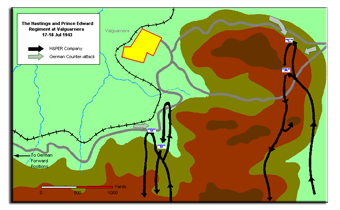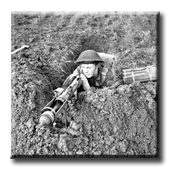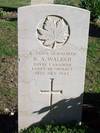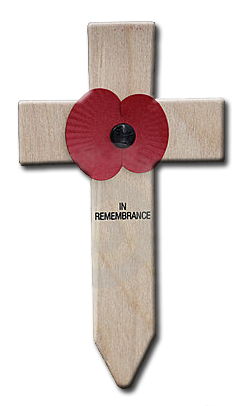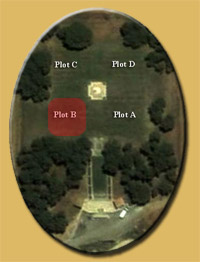










































In Memory of
WALKER, NORMAN ALAN
Signalman, K/29066
1 Div Sigs, Royal Canadian Corps of Signals
who died 26 age
18th July 1943
AGIRA WAR CEMETERY, SICILY

Born on 13 July 1917 in Edmonton, Alberta. Norman was killed on July 18, 1943 west of Valguarnera.
Valguarnera was a Battle Honour (the 28th in order) granted to Canadian regiments that fought around that town during the Battle of Sicily, a phase of the Italian Campaign during the Second World War.
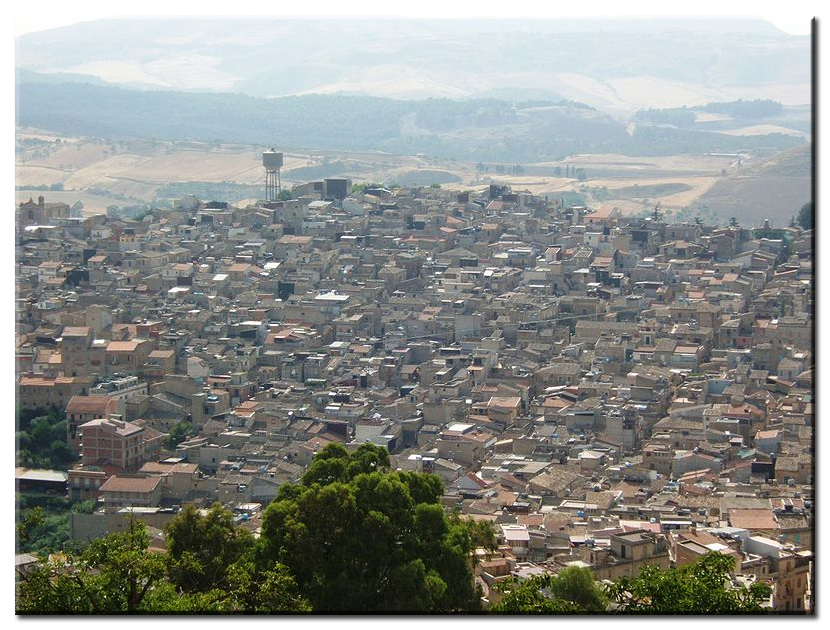 The previous battles around Piazza Armerina had demonstrated to the Canadians the type of actions the Germans were commited to fighting - sharp holding actions at key pieces of terrain. "But no matter how frustrating the German delaying tactics the Canadians, with equal determination, kept advancing and dislodging the enemy hill by hill and town by town."1 The 3rd Canadian Brigade continued the advance west and north on 17 Jul, proceeding up Route 117 with The Carleton and York Regiment in the lead, supported by Sherman Tanks of The Three Rivers Regiment.
The previous battles around Piazza Armerina had demonstrated to the Canadians the type of actions the Germans were commited to fighting - sharp holding actions at key pieces of terrain. "But no matter how frustrating the German delaying tactics the Canadians, with equal determination, kept advancing and dislodging the enemy hill by hill and town by town."1 The 3rd Canadian Brigade continued the advance west and north on 17 Jul, proceeding up Route 117 with The Carleton and York Regiment in the lead, supported by Sherman Tanks of The Three Rivers Regiment.
Ten miles north of Piazza Armerina, Highway No. 117 forks, splitting off to Enna to the west and Valguarnera to the east. Soldiers of Panzergrenadier Regiment 104 held the high ground overlooking this fork and the approaches to it.
The divisional commander, Major General Guy Simonds, kept his 3rd Brigade engaged frontally against the enemy, while dispatching the 1st Brigade off the east to outflank the town of Valguarnera itself.
The 3rd Brigade sent the Royal 22nd Regiment to secure Portello Crottacalda, a narrow pass, while The Carleton and York Regiment and The West Nova Scotia Regiment moved to the flanks of the dominating high ground, a feature known as Monte Della Forma. The attack on this feature was supported by the divisional artillery, the machine guns and mortars of the Saskatoon Light Infantry, and tanks of The Three Rivers Regiment in extremely hot weather. By late afternoon, both units were on their objectives.
"Near Valguarnera trained troops to fight in the mountains came into action. They are called "The boys of the mountains" and probably belong to the 1st Canadian Division."
(Field Marshal Kesselring)
..the enemy...occupied an exceedingly strong natural position a few miles past (Grammichele), and six miles south of the town of Valguarnera. Here, at noon, on July 17, Third Brigade crashed into the outposts and recoiled to try again.
With this preliminary failure to crack the German position frontally, First Brigade was given the task of making a wide right hook through the mountains to outflank the town. It was already dusk on the 17th, when the (Hastings and Prince Edward) Regiment received its orders to execute this grandiose manoeuvre.
Superficially the order seemed impossible of execution. Without prior reconnaissance, and in complete darkness, the Regiment was to cross ten miles of trackless mountain terrain, debouch upon a strongly defended town and force the enemy's withdrawal from his positions to the south. There could be no artillery or tank support and the men would only have what weapons and ammunition they could carry on their backs...the plan was daring, but most uncertain.
As night fell, the rifle companies moved off in single file into the dark wilderness and at once encoutnered a maze of nearly impassable mountains and canyons. The maps were useless and Able company, in the lead, advanced by guess-work...The going soon became so bad that the Regiment could not even maintain contace with its component parts. First Able (Company), then Charlie, became detached and disappeared into the gloom. Baker and Dog, with the CO, managed to stay together, but where they were going, or where they were at any given moment, no man could tell. Heavily laden (every man carried at least sixty pounds, and some carried nearly a hundred) they climbed cliff-faces and slithered down cactus-filled gulleys until they were so utterly fatigued that battle would have been welcome..4
Likewise, "A" and "C" Companies had drifted off to the east during the night, and after a brief separation found each other and near dawn dug in near a road. "A" Company managed to ambush a small German convoy carrying reinforcements. One platoon commander recalled the scene in his memoir:
I leapt to my feet to find the road no longer empty. Six mmense green-painted trucks were grinding to a halt below us. As I stared, incredulous, the lead truck nosed ponderously into the ditch, canted slowly on its side and spilled out two or three dozen gray-clad soldiers. Now I was screaming at my men, some of whom were still drugged with sleep, wildly urging the Bren gunners into action.
Over a hundred and fifty German infantrymen were packed into those six trucks. They had been driving all night, en route to reinforced their comrades who were holding up Third Brigade's advance, and most of them must have been drowsing or asleep when they were engulfed in gunfire.
For a moment I was distracted by Sharon and Robinson, that pair of usually phlegmatic farm boys, clamoring to know if they should bring our antitank projector into action. Then a furious bellow made me turn to see (company commander) Alex Campbell launching himself down the slope. He was holding a Bren tucked under his one good arm and firing quick bursts as he ran. Although a spare mag was clenched between his teeth, he was still able to roar like a maddened minotaur.
For precious seconds our fire grew ragged as we stared at Alex, appalled and awed by what he was doing. A few of the Germans tried to make use of the respite to bring rifles and Schmeisser machine-pistols into play. Alex was by then only a few yards from the nearest of them and I momentarily expected to see his mighty bulk come crashing to the ground. We all must have shared that fear, for suddenly every man in the two companies began to fire again as fast as he could load. The rattle and roar of small arms and grenades rose to a crescendo...and the stretch of road below us became a slaughterhouse.
Alex concentrated his berserk fury on a single truck...Within that truck twenty or more Germans writhed and died.
Meanwhile, soldiers from the other trucks were desperately trying to bail out through a thickening curtain of bullets, grenades and mortar bombs. Not many reached the dubious shelter of the roadside ditches, and most of those who did were wounded. As they and the few others who survived began making frantic efforts to surrender, the firing petered out and soon little groups of our men began herding prisoners off the road and up the hill.5
The road that "A" and "C" Company were on was the only eastward exit from Valguarnera, and "quite by accident the town had now been isolated, and the news of this calamity must soon have reached the German staff." The Germans soon began pulling back forces opposite the 3rd Brigade to deal with this situation in what had been their rear area.6
"A" and "C" Companies now came under attack from enemy troops "believed to be the previously uncommitted balance of a battalion." The companies, under threat of artillery fire, caused a withdrawal back into the hills. The battalion reassembled at their starting point on the highway, and found they had lost 20 men killed or wounded, and 7 had been taken prisoner by the Germans. It was later confirmed they had killed from 80 to 90 Germans and wounded many more.7
The Royal Canadian Regiment had also been ordered to approach the town by overland march from the highway and set off at 05:30 on the 18th. They managed to reach the southern approaches, their first actual enemy contact of the war.
On the hills about Valguarnera the RCR first met the Germans, the skillful soldiers who were to remain their opponents for the remainder of the campaign in Sicily, for eighteen months in Italy, and during the closing days of the war in Holland.
All day long the fighting raged; in mid-afternoon "A" and "B" Companies attacked in the fact of intense mortar and machine-gun fire, suffering numerous casualties but making good considerable high ground on the outskirts of town.8
The RCR were hampered by "the same series of causes arising from the uncompromising terrain - the immobilization of the unit carriers with their 3-inch mortars and wireless sets, the consequent breakdown of communications with the rest of the brigade, and the resultant loss of artillery support and absence of co-ordination with the flanking infantry battalion."9
The RCR arrived at positions south of Valguarnera after the Hasty P's had left; in fact, they managed to rescue some stragglers of the latter, who had been pinned down by enemy fire. They executed a two-company attack through intense fire with their CO, Lieutenant Colonel Crowe, personally leading the assault. The outnumbered enemy withdrew after "some spirited fighting", leaving the RCR overlooking the entrance to the town, now only half a mile to the north.Three German tanks barred the way into the town, and they opened fire.10
Eight Dog Company men (from the Hastings and Prince Edward Regiment), withdrawing under command of Sgt Major Turner, encountered the second-in-command of the R.C.R. coming forward on reconnaissance. This officer, Major Pope, insisted that the Hastings men accompany him and somewhat unwillingly they did so. It was nearly fatal to all of them. Turner was shot through the back by a sniper, but the survivors pushed forward into the inferno of the aroused valley. Reaching the road the came face to face with three MarK IV tanks supported by a platoon of German infantry.
Another history described Pope's action: No member of The (RCR) had spared himself so little since the landing as had "Billy" Pope and no man died more gallantly. At the head of a light patrol he advanced towards three enemy tanks, and taking a PIAT he personally attacked the monsters, though without success. A few minutes later, calmly smoking a cigarette, and meditating on a renewed effort, he was cut down by Spandau fire from one of the tanks he was seeking to destroy.12 The official history, however, states that "By extreme misfortune three bombs fired from a PIAT failed to explode. A hail of bullets from the tanks' machine-guns forced the patrol to retire; Major Pope was killed."13 The tanks withdrew, a mechanized column was observed leaving the town to the north, and the RCR prepared for a counter-attack. At 14:00 the CO sent a message to the brigade commander by runner (in fact, the regimental padre) stating that he intended to patrol forward, but could not do so until after dark owing to lack of support weapons and tanks. Valguarnera - 48th Highlanders |
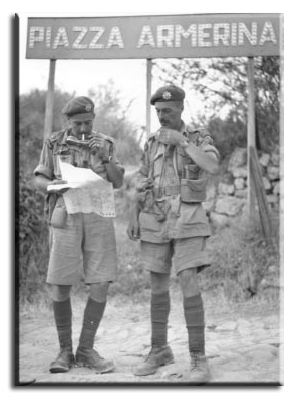
|
After dark, patrols (of the 48th) slipped into the town to find the 10,000 inhabitants hiding behind locked doors and the Germans gone. It was a quiet conclusion to a difficult day...If nothing else, the enemy's high command was aware that it was dealing with a force to be reckoned with. "Near Valguarnera troops trained for fighting in the mountains have been mentioned," Generalfeldmarschall Kesselring reported to Berlin. "They are called 'Mountain Boys' and probably belong to the 1st Canadian Division."15
Kesselring's troops had correctly identified the formation opposite them. It is unclear where the "Mountain Boys" title comes from, but one historian surmises that "the sobriquet must have come from the Germans themselves."16
Given the scale of the action - the first divisional level battle of the war for the Canadians - casualties were also heavier than had been since the landings on 10 Jul. Some 145 men were casualties, 40 of whom had been killed. German losses were estimated at 250 Germans and 30 Italians captured, and from 180 to 240 Germans killed or wounded. Nonetheless, "the actual gains of ground during the day were relatively small, so effectively had the enemy, although heavily outnumbered, capitalized on the advantages of his naturally strong positions. On the hand the Canadians had acquired some much-needed battle experience, which was to serve them well in subsequent encounters with the Germans."17
The following Canadian units were awarded the Battle Honour "Valguarnera" for participation in these actions:
 1st Canadian Armoured Brigade
1st Canadian Armoured Brigade
-
12th Canadian Armoured Regiment (The Three Rivers Regiment)
 1st Canadian Division
1st Canadian Division
-
The Saskatoon Light Infantry (MG)
 1st Canadian Brigade
1st Canadian Brigade
-
The Royal Canadian Regiment
-
The Hastings and Prince Edward Regiment
-
48th Highlanders of Canada
 3rd Canadian Brigade
3rd Canadian Brigade
-
Royal 22e Regiment
-
The Carleton and York Regiment
-
The West Nova Scotia Regiment
Notes
-
McKay, A. Donald Gaudeamus Igitur "Therefore Rejoice" (Bunker to Bunker Books, Calgary, AB, 2005) ISBN 1894255534 p.54
Ibid, p.54 -
Stacey, C.P. The Canadian Army 1939-1945: An Official Historical Summary (King's Printer, Ottawa, ON, 1948) p.101
-
Mowat, Farley. The Regiment (McClelland & Stewart Inc., Toronto, ON, 1955) ISBN 0771066945 (paperback edition) pp.105-107
-
Mowat, Farley And No Birds Sang (McClelland & Stewart Inc., Toronto, ON, 1979) ISBN 0770416322 pp.80-81
-
Mowat, The Regiment, Ibid, pp.109-110
-
Nicholson, Gerald. Official History of the Canadian Army in the Second World War. Volume II: The Canadians in Italy, 1943-1945 (Queen's Printer, Ottawa, ON, 1957) p.98
-
Galloway, Strome. A Regiment at War: The Story of The Royal Canadian Regiment 1939-1945 (Strome Galloway, 1979 - originally published in 1946 as "55 Axis") pp.75-76
-
Nicholson, Ibid, pp.98-99
-
Ibid, p.99
-
Mowat, Ibid, pp.110-111
-
Galloway, Ibid, pp.76-77
-
Nicholson, Ibid, p.99
-
Blatherwick, John and Hugh Halliday. Courage & Service: Second World War Awards to Canadians (Service Publications, Ottawa, ON) ISBN 1894581229
-
Dancocks, Daniel G. D-Day Dodgers: The Canadians in Italy 1943-1945 (McClelland & Stewart Inc., Toronto, ON, 1991) ISBN 0771025440 p.59
-
McKay, Ibid, pp.54-55
-
Nicholson, Ibid. p.100

